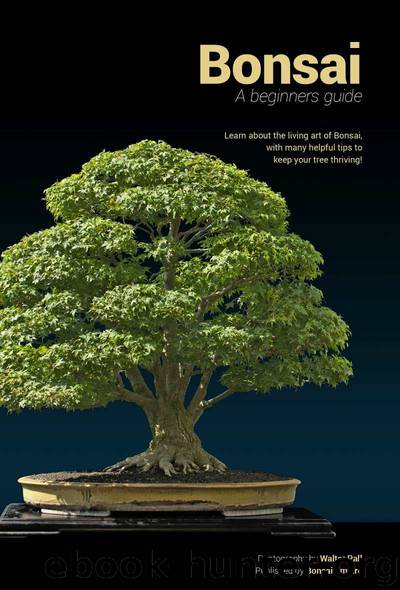Bonsai: A beginners guide by Bonsai Empire & O. Jonker

Author:Bonsai Empire & O. Jonker [Empire, Bonsai]
Language: eng
Format: epub
Publisher: Bonsai Empire
Published: 2014-08-20T22:00:00+00:00
Example of a Juniper Bonsai tree with extensive dead-wood, by Mauro Stemberger
Propagation: Use seeds or cuttings.
Acquisition: Many well-suited juniper species in different sizes are offered in most nurseries. You can often find good Bonsai raw material there. Specialized Bonsai traders offer everything from young plants, pre-Bonsai and pre-styled juniper trees up to high-value Bonsai, in various styles and shapes.
Pests / diseases: If junipers are well cared for and placed in an ideal position they are quite resistant against pests. It is important though not to let the foliage pads get too dense, because otherwise pests can settle in them more easily. During winter the junipers must be kept in a place with enough light and they must be checked for pests regularly because pests can even occur in winter. Junipers can sometimes get infested with spider mites, juniper scale, juniper aphids and juniper needle miners as well as juniper webworms for example. Customary insecticide / miticide sprays will help but you should also find the reason why the tree was prone to infestation.
A big problem is fungal rust. The diverse juniper species and cultivars have a very different level susceptibility to rust fungus, there are also some which are regarded as resistant. As a rule of thumb, the blue-green junipers are more resistant than those with yellowish-green foliage. The Japanese junipers are also not infested very often.
On the internet you can find files which list many juniper species and cultivars and their susceptibility / resistance level to rust fungus.
The rust fungus infests the junipers permanently and causes swellings from which hard, brown galls emerge. In spring, during rainy weather, the galls produce large, orange, gelatin-like tendrils, full of spores, which infest the leaves of pear trees (but there are also types of rust fungus which use hawthorn or crabapples as a second host instead of the pear).
The fungus causes orange spots on the pear leaves. In late summer brownish proliferations grow from the bottom sides of the leaves which release spores that infest junipers again.
While the pear trees in most cases are not fatally affected – they are newly infested each year again and they can even be treated successfully with a fungicide, an infested juniper normally cannot be cured. The visibly infested branches die in most cases and the fungus can emerge on other tree parts. Removing the parts with the swellings and galls is no guarantee at all that the fungus will not reappear. Although some people have a different opinion, it is best to immediately burn up a rust-infested juniper or put it into the garbage instead of your compost heap.
Download
This site does not store any files on its server. We only index and link to content provided by other sites. Please contact the content providers to delete copyright contents if any and email us, we'll remove relevant links or contents immediately.
Turbulence by E. J. Noyes(7940)
The Thirst by Nesbo Jo(6830)
Gerald's Game by Stephen King(4584)
Be in a Treehouse by Pete Nelson(3952)
Marijuana Grower's Handbook by Ed Rosenthal(3623)
The Sprouting Book by Ann Wigmore(3543)
The Red Files by Lee Winter(3368)
The Remains of the Day by Kazuo Ishiguro(3295)
Sharp Objects: A Novel by Gillian Flynn(2958)
Christian (The Protectors Book 1) by L. Ann Marie(2654)
Organic Mushroom Farming and Mycoremediation by Tradd Cotter(2631)
The Culinary Herbal by Susan Belsinger(2432)
Stone Building by Kevin Gardner(2353)
The Starter Garden Handbook by Alice Mary Alvrez(2285)
Lilac Girls by Martha Hall Kelly(2258)
The Unlikely Pilgrimage of Harold Fry by Rachel Joyce(2221)
The Lean Farm Guide to Growing Vegetables: More In-Depth Lean Techniques for Efficient Organic Production by Ben Hartman(2096)
Urban Farming by Thomas Fox(2061)
Backyard Woodland by Josh VanBrakle(1895)
